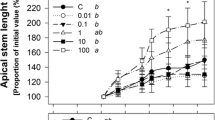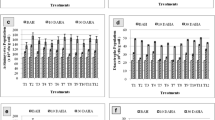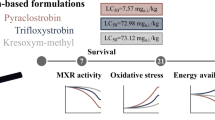Abstract
Frequently, sulfonamide antibiotic agents reach arable soils via excreta of medicated livestock. In this study, accumulation and phytotoxicity indicators were analyzed to evaluate the effects of sulfonamides on plants. In a greenhouse experiment, willow (Salix fragilis L.) and maize (Zea mays L.) plants were grown for 40 days in soil spiked with 10 and 200 mg kg−1 sulfadiazine (SDZ). Distribution of SDZ and major metabolites among bulk and rhizosphere soil, roots, leaves, and stems was determined using accelerated solvent extraction and LC − MS/MS analysis. Accumulation of SDZ was stronger in willow. The antibiotic was mainly stored inside roots and 4-hydroxy-sulfadiazine presence increased with the administered SDZ concentration. SDZ altered root geotropism, increased the lateral root number, and affected plant water uptake. The high concentration caused serious stress in willow (e.g., reduced C/N ratio and total chlorophyll content) and the death of maize plants. Even at environmentally relevant soil concentrations (10 mg kg−1), SDZ exhibited adverse effects on root growth, while at artificially high concentrations (200 mg kg−1), it showed a strong potential to impair plant performance and biomass. Willow, a fast growing tree species, showed potential for possible phytoremediation purposes.



Similar content being viewed by others
Abbreviations
- SDZ:
-
Sulfadiazine
- dm:
-
Dry mass
- fm:
-
Fresh mass
- 4-OH-SDZ:
-
4-hydroxy-sulfadiazine
- 5-OH-SDZ:
-
5-hydroxy-sulfadiazine
- N-Ac-SDZ:
-
N-acetyl-sulfadiazine
References
Antignac, J., Le Bizec, B., Monteau, F., & Andre, F. (2003). Validation of analytical methods based on mass spectrometric detection according to the “2002/657/EC” European decision: guideline and application. Analytica Chimica Acta, 483, 325–334.
Aust, M., Godlinski, F., Travis, G. R., Hao, X., McAllister, T. A., Leinweber, P., et al. (2008). Distribution of sulfamethazine, chlortetracycline and tylosin in manure and soil of Canadian feedlots after subtherapeutic use in cattle. Environmental Pollution, 156, 1243–1251.
Barret, M. (1995). Metabolism of herbicides by cytochrome P450 in corn. Drug Metabolism and Drug Interactions, 12, 299–316.
Bialk, H. M., Simpson, A. J., & Pedersen, J. A. (2005). Cross-coupling of sulfonamide antimicrobial agents with model humic constituents. Environmental Science and Technology, 39, 4463–4473.
Boonsaner, M., & Hawker, D. W. (2010). Accumulation of oxytetracycline and norfloxacin from saline soil by soybeans. Sciences of the Total Environment, 408, 1731–1737.
Boonsirichai, K., Guan, C., Chen, R., & Masson, P. H. (2002). Root gravitropism: an experimental tool to investigate basic cellular and molecular processes underlying mechanosensing and signal transmission in plants. Annual Review of Plant Biology, 53, 421–447.
Boxall, A. B. A., Fogg, L. A., Blackwell, P. A., Blackwell, P., Kay, P., Pemberton, E. J., et al. (2004). Veterinary medicines in the environment. Reviews of Environmental Contamination and Toxicology, 180, 1–9.
Boxall, A. B. A., Johnson, P., Smith, E. J., Sinclair, C. J., Stutt, E., & Levy, L. S. (2006). Uptake of veterinary medicines from soils into plants. Journal of Agricultural and Food Chemistry, 54, 2288–2297.
Burken, J. G. (2003). Uptake and metabolism of organic compounds: green-liver model. In S. C. McCutcheon & J. L. Schnoor (Eds.), Phytoremediation: transformation and control of contaminants (pp. 59–84). Hoboken: Wiley.
Chiou, C. T., Kile, D. E., Rutherford, D. W., Sheng, G., & Boyd, S. A. (2000). Sorption of selected organic compounds from water to a peat soil and its humic-acid and humin fractions: potential sources of the sorption nonlinearity. Environmental Science and Technology, 34, 1254–1258.
Christian, T., Schneider, R. J., Färber, H. A., Skutlarek, D., Meyer, M. T., & Goldbach, H. E. (2003). Determination of antibiotic residues in manure, soil, and surface waters. Acta Hydrochimica et Hydrobiologica, 31, 36–44.
De Liguoro, M., Poltronieri, C., Capolongo, F., & Montesissa, C. (2007). Use of sulfadimethoxine in intensive calf farming: evaluation of transfer to stable manure and soil. Chemosphere, 68, 671–676.
R Development Core Team (2008). R: a language and environment for statistical computing. RFoundation for Statistical Computing, Vienna. http://www.R-project.org.
Ding, C., & He, J. (2010). Effect of antibiotics in the environment on microbial populations. Applied Microbiology and Biotechnology, 87, 925–941.
Dolliver, H., Kumar, K., & Gupta, G. (2007). Sulfamethazine uptake by plants from manure-amended soil. Journal of Environmental Quality, 36, 1224–1230.
Ferro, S., Trentin, A. R., Caffieri, S., & Ghisi, R. (2010). Antibacterial sulfonamides: accumulation and effects in barley plants. Fresenius Environmental Bulletin, 19, 2094–2099.
Förster, M., Laabs, V., Lamshöft, M., Pütz, T., & Amelung, W. (2008). Analysis of aged sulfadiazine residues in soils using microwave extraction and liquid chromatography tandem mass spectrometry. Analytical and Bioanalytical Chemistry, 391, 1029–1038.
Förster, M., Laabs, V., Lamshöft, M., Groeneweg, J., Zühlke, S., Spiteller, M., et al. (2009). Sequestration of manure-applied sulfadiazine residues in soils. Environmental Science and Technology, 43, 1824–1830.
Gerhardt, K. E., Huang, X., Glick, B. R., & Greenberg, B. M. (2009). Phytoremediation and rhizoremediation of organic soil contaminants: potential and challenges. Plant Science, 176, 20–30.
Grote, M., Vockel, A., Schwarze, D., Mehlich, A., & Freitag, M. (2004). Fate of antibiotics in food chain and environment originating from pigfattening (part 1). Fresenius Environmental Bulletin, 13, 1216–1224.
Grote, M., Schwake-Anduschus, C., Michel, R., Langenkämper, G., Betsche, T., Hayen, H., et al. (2007). Aufnahme und Transport von Tierarzneistoffen in Nutzpflanzen. In R. Röder, K. Weiß, & M. Sengl (Eds.), Tierarzneimittel in der Umwelt (pp. 161–173). Munich: Oldenbourg Industrieverlag.
Halling-Sørensen, B., Nors Nielsen, S., Lanzky, P. F., Ingerslev, F., Holten Lützhøft, H. C., & Jørgensen, S. E. (1998). Occurrence, fate and effects of pharmaceutical substances in the environment—a review. Chemosphere, 36, 357–393.
Hammesfahr, U., Heuer, H., Manzke, B., Smalla, K., & Thiele-Bruhn, S. (2008). Impact of the antibiotic sulfadiazine and pig manure on the microbial community structure in agricultural soils. Soil Biology and Biochemistry, 40, 1583–1591.
Hamscher, G., Sczesny, S., Hoper, H., & Nau, H. (2002). Determination of persistent tetracycline residues in soil fertilized with liquid manure by high-performance liquid chromatography with electrospray ionization tandem mass spectrometry. Analytical Chemistry, 74, 1509–1518.
Hamscher, G., Pawelzick, H. T., Sczesny, S., Nau, H., & Hartung, J. (2003). Antibiotics in dust originating from a pig-fattening farm: a new source of health hazard for farmers? Environmental Health Perspectives, 111, 1590–1594.
Hölzel, C. S., Harms, K. S., Küchenhoff, H., Kunz, A., Müller, C., Meyer, K., et al. (2010). Phenotypic and genotypic bacterial antimicrobial resistance in liquid pig manure is variously associated with contents of tetracyclines and sulfonamides. Journal of Applied Microbiology, 108, 1642–1656.
Höper, H., Kues, H., Nau, H., & Hamscher, G. (2002). Eintrag und Verbleib von Tierarzneimittelwirkstoffen in Böden. Bodenschutz, 4, 141–148.
Jjemba, P. K. (2002). The potential impact of veterinary and human therapeutic agents in manure and biosolids on plants grown on arable land: a review. Agriculture, Ecosystems and Environment, 93, 267–278.
Jørgensen, S. E., & Halling-Sørensen, B. (2000). Drugs in the environment. Chemosphere, 40, 691–699.
Kreuzig, R., & Höltge, S. (2005). Investigations on the fate of sulfadiazine in manured soil: laboratory experiments and test plot studies. Environmental Toxicology and Chemistry, 24, 771–776.
Kumar, K. (2005). Antibiotic use in agriculture and its impact on the terrestrial environment. Advances in Agronomy, 87, 1–54.
Kuzovkina, Y. A., & Quigley, M. F. (2005). Willows beyond wetlands: uses of Salix L. species for environmental projects. Water, Air and Soil Pollution, 162, 183–204.
Langhammer, J.-P., Führ, F., & Büning-Pfaue, H. (1990). Verbleib von Sulfonamid-Rückständen aus der Gülle in Boden und Nutzpflanze. Lebensmittelchemie, 44, 93.
Li, Z., Alfenito, M., Rea, P. A., Walbot, V., & Dixon, R. A. (1997). Vacuolar uptake of the phytoalexin medicarpin by the glutathione conjugate pump. Phytochemistry, 45, 689–693.
Lichtenthaler, H. K. (1987). Chlorophylls and carotenoids: pigments of photosynthetic biomembranes. Methods in Enzymology, 148, 350–382.
Liu, F., Ying, G.-G., Tao, R., Zhao, J.-L., Yang, J.-F., & Zhao, L.-F. (2009). Effects of six selected antibiotics on plant growth and soil microbial and enzymatic activities. Environmental Pollution, 157, 1636–1642.
Lynch, J. (1995). Root architecture and plant productivity. Plant Physiology, 109, 7–13.
Marschner, P. (2012). Mineral nutrition of higher plants (thirdth ed., p. 651). San Diego: Academic.
Michelini, L., Meggio, F., La Rocca, N., Ferro, S., & Ghisi, R. (2012). Accumulation and effects of sulfadimethoxine in Salix fragilis L. plants: a preliminary study to phytoremediation purposes. International Journal of Phytoremediation, 14, 388–402.
Migliore, L., Brambilla, G., Cozzolino, S., & Gaudio, L. (1995). Effect on plants of sulphadimethoxine used in intensive farming (Panicum miliaceum, Pisum sativum and Zea mays). Agriculture, Ecosystems and Environment, 52, 103–110.
Migliore, L., Brambilla, G., Casoria, P., Civitareale, C., Cozzolino, S., & Gaudio, L. (1996). Effect of sulphadimethoxine contamination on barley (Hordeum distichum L., Poaceae, Liliposida). Agriculture, Ecosystems and Environment, 60, 121–128.
Migliore, L., Civitareale, C., Cozzolino, S., Casoria, P., Brambilla, G., & Gaudio, L. (1998). Laboratory models to evaluate phytotoxicity of sulphadimethoxine on terrestrial plants. Chemosphere, 37, 2957–2961.
Migliore, L., Rotini, A., Cerioli, N. L., Cozzolino, S., & Fiori, M. (2010). Phytotoxic antibiotic sulfadimethoxine elicits a complex hormetic response in the weed Lythrum salicaria L. Dose–response, 8, 414–427.
Mikes, O., & Trapp, S. (2010). Acute toxicity of the dissociating veterinary antibiotics trimethoprim to willow trees at varying pH. Bulletin of Environmental Contamination and Toxicology, 85, 556–561.
Pilon-Smits, E. (2005). Phytoremediation. Annual Review of Plant Biology, 56, 15–39.
Pressman, B. C., Harris, E. J., Jagger, W. S., & Johnson, J. H. (1967). Antibiotic-mediated transport of alkali ions across lipid barriers. Proceedings of the National Academy of Sciences of the United States of America, 58, 1949–1956.
Sarmah, A. K., Meyer, M. T., & Boxall, A. B. A. (2006). A global perspective on the use, sales, exposure pathways, occurrence, fate and effects of veterinary antibiotics (VAs) in the environment. Chemosphere, 65, 725–759.
Sartorius, M., Riccio, A., Cermola, M., Casoria, P., Patriarca, E. J., & Taté, R. (2009). Sulphadimethoxine inhibits Phaseolus vulgaris root growth and development of N-fixing nodules. Chemosphere, 76, 306–312.
Schachtman, D. P., & Schroeder, J. I. (1994). Structure and transport mechanism of a high-affinity potassium uptake transporter from higher plants. Nature, 370, 655–658.
Schmitt, H., Haapakangas, H., & Van Beelen, P. (2005). Effects of antibiotics on soil microorganisms: time and nutrients influence pollution-induced community tolerance. Soil Biology and Biochemistry, 37, 1882–1892.
Schwarz, J., Aust, M.-O., & Thiele-Bruhn, S. (2010). Metabolites from fungal laccase-catalysed transformation of sulfonamides. Chemosphere, 81, 1469–1476.
Stokstad, E. L. R., & Jukes, T. H. (1987). Sulfonamides and folic acid antagonists: a historical review. Journal of Nutrition, 117, 1335–1341.
Sukul, P., & Spiteller, M. (2006). Sulfonamides in the environment as veterinary drugs. Reviews of Environmental Contamination and Toxicology, 187, 67–101.
Taiz, L., & Zeiger, E. (2009). Fisiologia vegetale (thirdth ed., p. 446). Padova: Piccin.
Thiele-Bruhn, S. (2003). Pharmaceutical antibiotic compounds in soils—a review. Journal of Plant Nutrition and Soil Science, 166, 145–167.
Thiele-Bruhn, S., Seibicke, T., Schulten, H. R., & Leinweber, P. (2004). Sorption of sulfonamide pharmaceutical antibiotics on whole soils and particle-size fractions. Journal of Environmental Quality, 33, 1331–1342.
Trapp, S., & Karlson, U. (2001). Aspects of phytoremediation of organic pollutants. Journal of Soils and Sediments, 1, 37–43.
Trapp, S., Matthies, M., Scheunert, I., & Topp, E. M. (1990). Modeling the bioconcentration of organic chemicals in plants. Environmental Science and Technology, 28, 1246–1252.
Wehrhan, A., Streck, T., Groeneweg, J., Vereecken, H., & Kasteel, R. (2010). Long-term sorption and desorption of sulfadiazine in soil: experiments and modeling. Journal of Environmental Quality, 39, 654–666.
Zacchini, M., Pietrini, F., Scarascia Mugnozza, G., Iori, V., Pietrosanti, L., & Massacci, A. (2009). Metal tolerance, accumulation and translocation in poplar and willow clones treated with cadmium in hydroponics. Water, Air, and Soil Pollution, 197, 23–34.
Zayed, A., Gowthaman, S., & Terry, N. (1998). Phytoaccumulation of trace elements by wetlands plants: I. Duckweed. Journal of Environmental Quality, 27, 715–721.
Acknowledgments
This work was partly funded by a grant of “Ing. Aldo Gini” Foundation and through the financial support of Veneto Agricoltura Agency and of the German Research Foundation DFG. The support and assistance of M.-O. Aust, E. Sieberger, and P. Ziegler is highly appreciated. We thank B.-M. Wilke and two anonymous reviewers for valuable comments on the manuscript.
Author information
Authors and Affiliations
Corresponding author
Electronic supplementary materials
Below is the link to the electronic supplementary material.
ESM 1
(DOC 10591 kb)
Rights and permissions
About this article
Cite this article
Michelini, L., Reichel, R., Werner, W. et al. Sulfadiazine Uptake and Effects on Salix fragilis L. and Zea mays L. Plants. Water Air Soil Pollut 223, 5243–5257 (2012). https://doi.org/10.1007/s11270-012-1275-5
Received:
Accepted:
Published:
Issue Date:
DOI: https://doi.org/10.1007/s11270-012-1275-5




